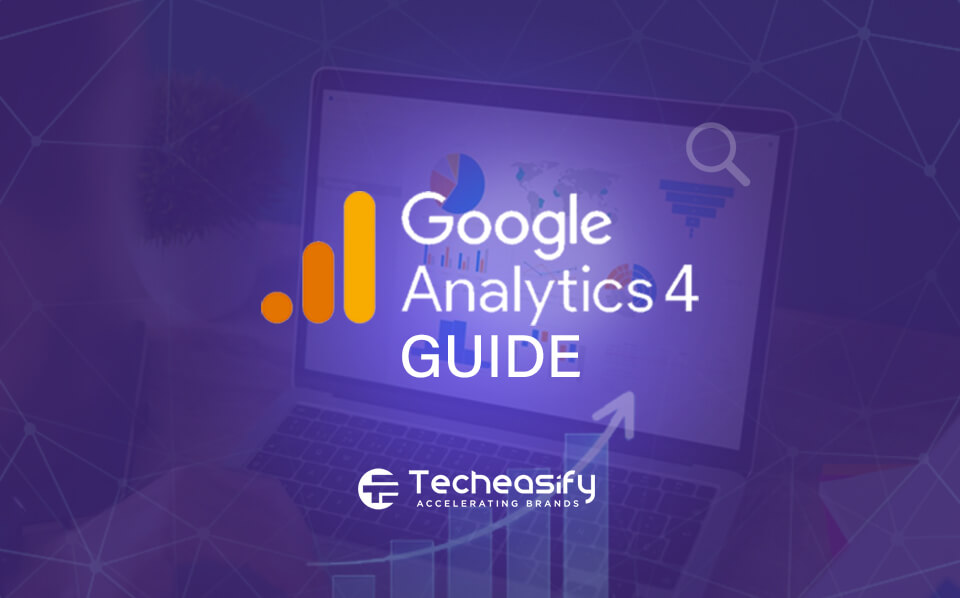Google Analytics 4 (GA4) is the latest version of Google’s web and app analytics platform, which was launched in October 2020. It aims to assist modern businesses in measuring and optimising their web presence across platforms and devices. Analytics Google has a few advantages over its predecessor, Universal Analytics (UA). For example:
- It keeps tabs on users and activities through a single data model, regardless of whether it’s a website or an app.
- It employs an event-based measurement model that can be tailored to fit different circumstances.
- Tracking across different devices and platforms has been intensified.
- There are tools for predicting customers’ next steps as well as advanced user journey analysis.
- In addition, it works seamlessly with Google Signals to provide more information about your target audience.
- Lastly, it has improved data privacy features and GDPR compliance possibilities.
This blog post will walk you through setting up GA4, understanding its data structure, exploring its interface, mastering its features, and using its data to improve your website or app performance. By the time you finish reading this blog post, you will be able to use GA4 for better insights into who visits your site or uses your application online and how they behave once there.
How to set up Google Analytics 4?
- You need to create a Google Analytics account unless you already have one. Go to https://analytics.google.com and then click Start measuring. Then, enter an account name and change the data-sharing settings before proceeding.
- The next step is to create a new Google Analytics 4 property. Put a name on the property, select the reporting time zone and currency, and click next. After that, choose your industry category, business size, and how you would want to use Google Analytics. Press Create, and then accept terms and services.
- Add a data stream to start collecting data. In Admin, under Data Streams, click Web. Among other things, enter your website URL and stream name while keeping Enhanced Measurement active. The next step requires the creation of Stream after hitting Create Stream, followed by copying the Measurement ID.
- To install Analytics Google code on your website, set up Google Tag Manager. Create an account and a container for your website. Click on Tags, choose New and then proceed to Tag Configuration. Click Google Analytics: GA4 Configuration and paste the Measurement ID. Click Triggering and select All Pages. Lastly, click Save and Submit.
- To measure conversions on your site, set up goals. Go to Google Analytics, click on Events, then Create Event. Add the name of the event, description and condition. Click Save and turn on the Mark as conversion toggle button.
Setting up GA4
A Google Analytics set-up is the crucial first step towards harnessing its power. The process varies depending on your current analytics setup and specific measurement needs. Here are the main options:
- Existing UA Property : If you have a Universal Analytics property, creating a new GA4 property alongside it allows you to collect and compare data from both versions, facilitating a gradual migration to GA4.
- Starting from Scratch : For those starting anew, creating a fresh GA4 property and installing the web tracking code on your website or integrating with platforms like Firebase, Google Tag Manager, or Google Ads ensures comprehensive data collection.
- Website and App Integration : If you operate both a website and an app, creating a single ga4 Google Analytics property and using the same tracking code or integration provides a unified platform to measure and analyse user activities.
Google website analytics provides features such as IP anonymisation, data deletion controls, consent management integration, user ID and client ID hashing, and opt-out and opt-in mechanisms to respect user privacy preferences. Consultation with legal and technical advisors ensures compliance with applicable laws and regulations.
Understanding GA4 Data Structure
Compared to UA, GA4 has a data structure and terminology that are confusing. However, once you get the main ideas and variations, you will be able to make sense of your GA4 data with no problem.
- Events : In GA4, events are the basic unit of measurement. They represent any user interaction or activity that you want to track on your website or app, such as page views, button clicks, purchases, downloads, etc. Some common events are collected automatically by GA4, but you can also define your own custom events in order to capture specific user actions and goals.
- Parameters : They refer to additional details attached to events in order to provide more context and precision. For example, under category, one may add parameters like label or value etc., thereby describing what event is characterised by and how it came out.
- Dimensions : These refer to attributes or characteristics of users, events or items (products or articles), which can be used for segmentation and filtering purposes in your analytics tool.
The main difference between GA4 and UA data structure is that GA4 uses a flat and flexible event-based model, while UA uses a hierarchical and rigid session-based model. This means that in GA4, you can track any user action or activity as an event, regardless of the platform or device, and attach any parameters, dimensions, or metrics to it without having to follow a predefined schema or structure. In UA, however, you have to follow a fixed structure of sessions, hits and scopes such as user, session, hit or product to track and organise your data, which can limit your measurement and analysis capabilities.
Mastering GA4 Features
GA4 introduces a suite of features aimed at elevating your analytical capabilities :
- Cross-Device and Cross-Platform Tracking : Track and analyse users across different devices and platforms, leveraging the User ID feature for a unified view.
- User Journey Analysis : Understand and visualise user journeys with Funnel Analysis and Path Analysis features.
- Predictive Analytics : Utilize machine learning and artificial intelligence to predict user actions and outcomes.
- Custom Dashboards and Reports : Tailor your analytics experience with personalised dashboards and reports.
- Google Signals Integration : Seamlessly integrate with Google Signals for cross-device remarketing and reporting.
Using GA4 Data to Improve Website/App Performance
Leveraging GA4 data can be a game-changer for optimising website or app performance. Here are some tips :
- If you want to know more about the user behaviour on your website or app, including the number of pages they view, the mean amount of time spent on each page, the frequency with which they return, and the events that were triggered by their actions, view the Engagement report. You can employ this data to improve your content and features by learning which ones people like the most.
- Check out the Acquisition report for insights on how people find your site, with info about sources of traffic, medium type (organic search, social media), campaigns’ effectiveness and keywords used in searches. With this, marketing channels can be evaluated better, leading to improved customer attraction efforts and higher retention rates for more users.
- Go through Monetization reports to know how users contribute revenue, including products and services bought by them, subscriptions taken up, ads clicked on, and overall value created by them, among others. This serves as a baseline for measuring conversion efficiency as well as monetisation performance improvement goal setting.
- Look into the Retention report to learn about user loyalty, such as how often customers return after their first visit. Such awareness assists in finding ways of increasing retention figures while also increasing loyalty scores, leading to better strategies aimed at sustained engagement.
Conclusion
Google Analytics 4 stands as a powerful and flexible analytics platform, providing the tools necessary to measure and optimise website or app performance across devices and platforms. When it comes to digital optimisation, you can also consider teaming up with Techeasify. Techeasify is a leading digital marketing company that offers a wide range of services, such as SEO, PPC, SMM, web design, graphic design, and email marketing. If you want to create leads for potential sales, improve your brand reputation online, increase traffic on your website, or boost sales for your online store, then let Techeasify help you out.




